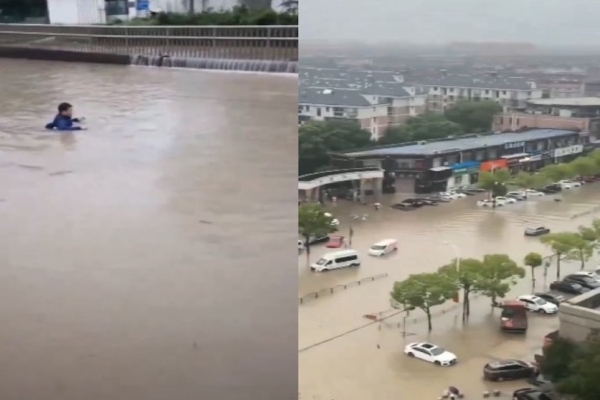Shanghai residents in Fengxian District and Minhang District revealed on September 21st that the impact of Typhoon “Pulsa” has not completely dissipated, with wind speeds of 2 to 3 on the local scale still present. Earlier, Shanghai was hit by heavy rainfall due to Typhoon “Pulsa”, causing the city to be submerged in water.
According to the mainland weather network on the 21st, Typhoon No. 14 of this year, “Pulsa” (tropical storm level), made landfall on the coastal areas of southwestern Jeolla Province, South Korea at 3:30 pm with maximum wind speeds near the center reaching 8 on the Beaufort scale, 18 meters per second. This was the third landfall of the typhoon.
“Plusa” had previously made landfall in Shanghai, and even though it has left, the local area is still feeling the effects. On the 21st, residents of Fengxian District in Shanghai told Epoch Times reporters that there were still some effects, with “wind speeds of 2 to 3, and rain.”
A resident named Long Yu (pseudonym) in Minhang District, Shanghai, told Epoch Times reporters that the wind in Minhang has not completely subsided on the 21st, “the wind is still quite strong today,” indicating that it should be leaving Shanghai soon.
According to the mainland meteorological agency, from 2 pm on the 21st to 2 pm on the 22nd, due to the combined influence of “Pulsa” and cold air, the Bohai Sea, Yellow Sea, large parts of the East China Sea, coastal areas of Jiangsu, Yangtze River Estuary, Hangzhou Bay, Shanghai coast, and other coastal areas will experience strong winds of 6 to 7 on the Beaufort scale, with gusts of 8 to 9, with some areas of the southeastern part of the Yellow Sea and the western part of the East China Sea experiencing wind speeds of 8, and gusts of 9 to 10.
On the evening of September 19th at 6:50 pm, “Pulsa” made landfall on the coastal areas of Daishan County, Zhoushan City, Zhejiang Province, with maximum wind speeds near the center reaching 10 on the Beaufort scale (25 meters per second); and around 9:45 pm on the same day, it made a second landfall on the coastal areas of Fengxian District, Shanghai, with maximum wind speeds near the center reaching 9 on the Beaufort scale (23 meters per second). In the early hours of the 20th, “Pulsa” moved from Shanghai to Kunshan City, Jiangsu Province; and then did a “turnabout,” with a tornado appearing in Qingpu District, Shanghai.
Long Yu recalled the situation when the typhoon hit. He said that at the time, the disaster in Pudong New Area was more severe, with strong winds and heavy rain, “cars, roads were flooded, and branches were blown down.”
Li Ming (pseudonym) in Pudong New Area told Epoch Times reporters that at the time, there was “heavy rain, in many places, water came up on the streets.” He Lin (pseudonym) in Fengxian District revealed, “the residential areas were all submerged, cars were soaked, trees were all downed.” “It was very tragic!”
Videos circulated online showed that the Lingang New Area in Pudong, Huinan Metro Station in Pudong New Area and other areas of Shanghai had severe waterlogging; in some videos, the water had reached waist-deep on people. Netizens criticized: “The drainage system is useless! The whole city was unprepared.”
Previously, netizens analyzed that the floods in China are really the responsibility of the Chinese Communist Party. 1. Officials focus on the surface construction, neglecting the construction of underground drainage systems and flood control measures. 2. Despite heavy rains, reservoirs fail to release water beforehand, leading to clandestine discharge when they reach full capacity. 3. Corruption is a social norm in China. Even if infrastructure projects are carried out, they appear impressive on the surface, such as the sponge city project in Zhengzhou costing billions. However, the drainage covers are lifted to reveal no actual water channels beneath, just soil.

